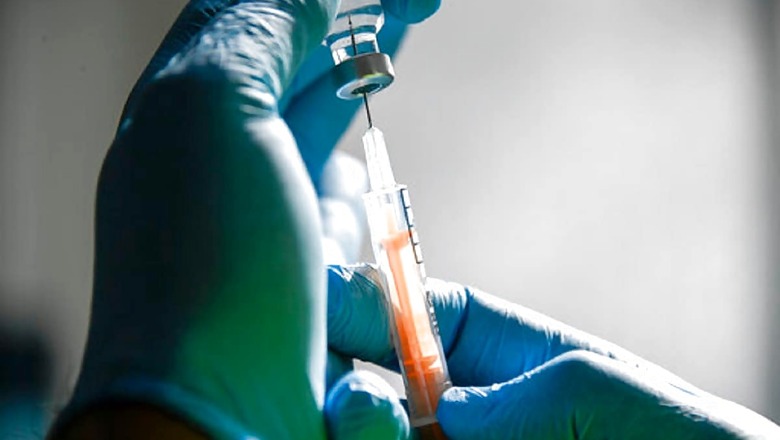
views
Vaccines are generally prophylactic – intended to prevent disease. They are not for treatment after the disease has been established. This means if a person gets vaccinated against a disease, he or she may be protected from it. But if a person already has the symptoms of a disease, then a vaccine cannot be the treatment, except in a few cases where therapeutic vaccines are used against HIV, cancer, etc. Our body has a natural defence mechanism in the form of antibodies against pathogens, acting as an army against invaders or enemies. Whenever our body is exposed to any pathogen (virus, bacteria, fungus, etc) for the first time, it may take a while to develop antibodies. In the meantime, symptoms may also appear for a person who is susceptible.
Once a specific pathogen’s antibodies are developed, they teach the immune system to fight that pathogen. One type of antibodies will not work against all pathogens attacking our body. Therefore, for every newly emerging pathogen, we have to produce antibodies in our body so that we can combat that pathogen at the time of attack.
Hence, the concept of vaccines came into the picture.
Vaccines are the very pathogens against which one needs protection
Vaccines act as an army to combat incoming enemies attacking our body. Vaccines are produced against either a subpart of a pathogen or the whole pathogen: this means that the whole pathogen is used to produce antibodies in our body and that pathogen acts as a vaccine. For a layperson, vaccines are nothing but the very pathogens against which one needs protection. But a question can be asked: if that pathogen is injected into the body, will it cause disease?
Yes, surely it causes disease. Therefore, live pathogens are generally not used for the process. Rather, attenuated or inactive pathogens are used to produce vaccines, which will not cause any disease or symptoms under normal circumstances.
There are different approaches to produce vaccines, such as using the inactive part or whole attenuated pathogens, mRNA-based ones, and vector-based vaccines.
The case of Covid-19
Now, I will explain by taking the specific example of the Covid-19 virus (SARS-CoV-2) and its vaccines from the Indian perspective. There are two vaccines being used in India right now: Covaxin and Covishield. Covaxin is an inactivated/attenuated vaccine, which was prepared on a tried-and-tested platform of dead viruses.
This vaccine has been developed with the whole-virion inactivated vero cell-derived technology. They contain inactivated viruses that cannot infect a person but can still train the immune system to prepare a defence mechanism against the active virus and help fight against it.
It was developed by Hyderabad-based Bharat Biotech International Ltd in association with the Indian Council of Medical Research (ICMR) and the National Institute of Virology (NIV).
Covishield is a vector-based vaccine: it is not a whole virus, rather only a gene for producing spike proteins against which antibodies develop when injected in the body as a vaccine.
Covishield has been prepared using the viral vector platform, which is a totally different technology. A chimpanzee adenovirus – ChAdOx1 – was modified to enable it so that it can carry the Covid-19 spike protein into the cells of humans.
This cold virus is basically not capable of infecting a person who takes the vaccine and trains the immune system well to fight the Covid-19 virus.
Covishield has been developed by Oxford-AstraZeneca and is being manufactured by the Serum Institute of India (SII). No vaccine has 100% efficiency and neither do these two: Covishield is reported to have about 90% and Covaxin 81% as per WHO data.
The big question: Can a person get infected after vaccination?
Now the big question is whether a person after getting a vaccine may get infected or not? Yes, he or she may be infected, but infection does not always mean that a person has the disease. Even after infection, some mild symptoms may appear, but usually, these may not aggravate to the diseased condition leading to any fatality.
Let it be clear at this point that the pathogenicity (disease-causing ability) level of any pathogen depends on two factors: one is load of pathogen (virus) and the second is the host’s (infected person’s) defence system which acts as soldiers to kill pathogens.
For instance, if 100 soldiers are present in an army to defend against 10,000 enemies as situation 1, and 1,000 soldiers are available in an army to combat 1,000 or fewer enemies as situation 2, of course, in the second scenario the virus as an enemy cannot cause disease even after an attack on the body since the army is strong.
What are infection and disease?
Vaccinated people may get infection but not full disease symptoms. However, they may still be carriers for others. So what are infection and disease? Infection means the entry of a virus in the body through the penetration process but disease means after penetration in the cell it multiplies and completes its life cycle to produce hundreds of viruses and infect other neighbouring cells to destroy that part of the body which it infects.
This leads to specific symptoms called disease. In the case of vaccination, a person already has antibodies to neutralise the virus. When infection occurs, antibodies (vaccines) kill that virus and let it not develop into full disease.
(Dr Asad U Khan is Professor of Microbiology in Interdisciplinary Biotechnology Unit, AMU, Aligarh. Views expressed are personal.)
Read all the Latest News, Breaking News and Coronavirus News here. Follow us on Facebook, Twitter and Telegram.

















Comments
0 comment